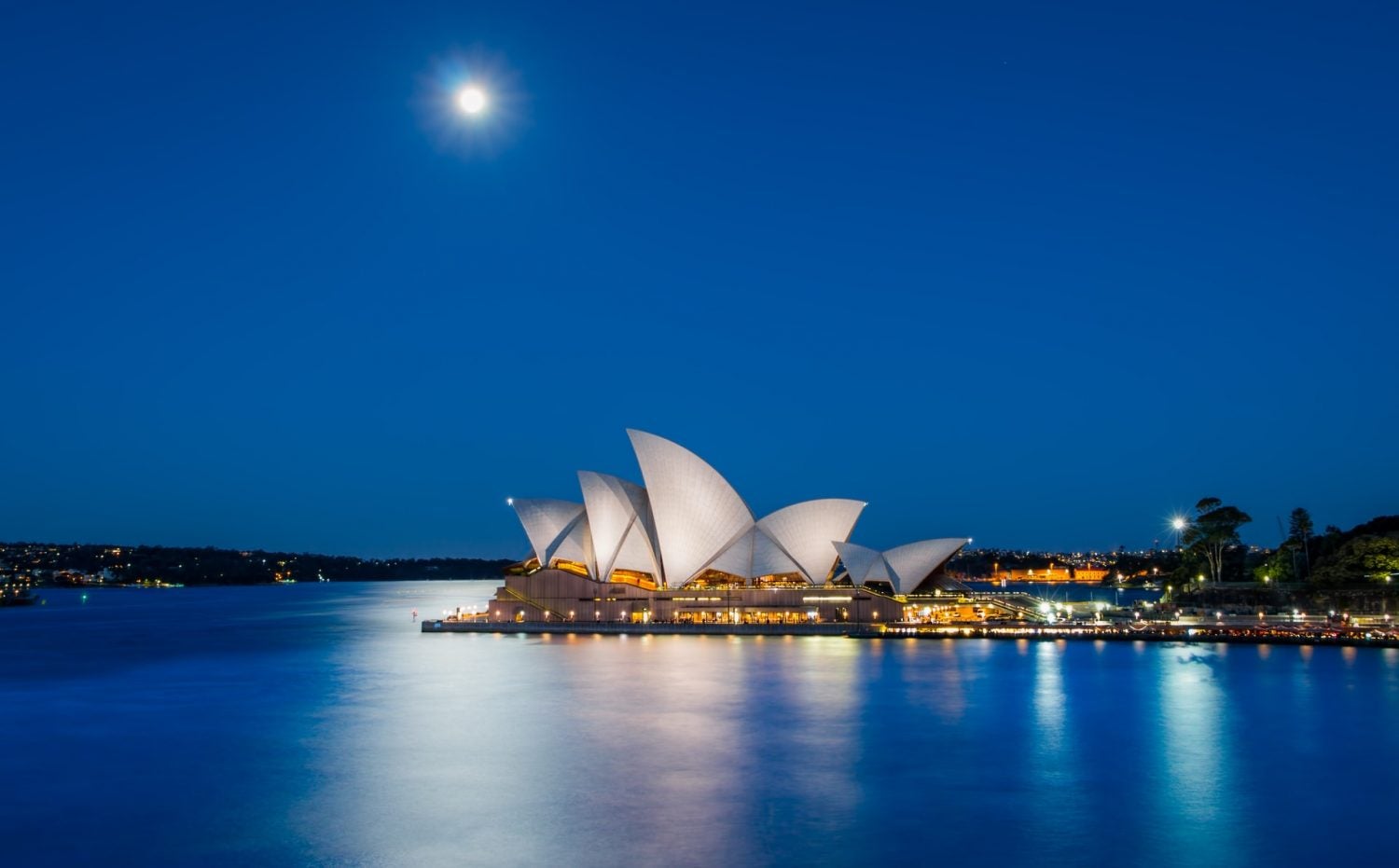Ok, it might seem like a lot, but did you know there are around 10,000 cities in the world, according to the World Urban Research?
That’s a lot of potential architecture to talk about. This article covers a mere 0.32%, so really, it’s not all that much after all. And – after reading this – you’ll soon see why we’ve included them all.
1. Aarhus, Denmark
Its name even sounds like a type of architecture, doesn’t it?
This laid-back city in Denmark is filled with cutting-edge structures. It includes the waterfront ‘iceberg’ apartment building, which looks like it’s coming out of the water in shards and the ARos Art Museum that plays with reflection and texture to create a rainbow panorama out of colorful curved glass walls.
2. Amsterdam, Netherlands
Some of the most magnificent architectural structures find themselves here – such as the 19th century Dutch Renaissance buildings and picturesque canals.
3. Sydney, Australia
Just for the Sydney Opera House alone – one of the world’s most iconic buildings! (Although there’s obviously lots more here, too!) If your keen on checking out property around Sydney, be sure to get in touch with a local mortgage broker like Get a Better Rate!
4. Bagan, Myanmar
Home to thousands of religious structures that come alive during sunrise and sunset, thanks to the glistening of the golden pagodas.
5. Berlin, Germany
The buildings in Berlin are more than just bricks and mortar; they’re a living testament to a rich intellectual, cultural and historical legacy. It’s a varied collection that reflects the city’s evolution throughout the 20th century, and it’s truly a sight to behold.
6. Yucatán Peninsula, Mexico
Step back in time with the remarkable Mayan sites still standing here – such as Chichen Itza – and discover why they are designated UNESCO World Heritage Sites.
7. Buenos Aires, Argentina
The buildings here reflect the hustle and bustle of this cosmopolitan city; an eclectic mix of styles and influences which results in a genuinely diverse treat for the senses! From impressive skyscrapers (which you can appreciate as part of a backdrop for an epic Tango Show) to charming colonial buildings, Buenos Aires has it all.
8. Bruges, Belgium
A mishmash of medieval and modern architecture makes up this historic town full of well-preserved buildings and monuments.
9. Thimphu, Bhutan
This sacred-yet-striking city is tucked away in the Himalayas, juxtaposing ancient architectural gems and holy temples with modern luxury hotels.
10. Kuala Lumpur, Malaysia
A refreshing blend of colonial and contemporary influences, head to the Petronas Towers (the city’s most iconic architectural feat and among the world’s tallest buildings) for the most mesmerizing views from a sensational exhibit made up of glass and steel. Malacca City is a living museum bursting with preserved buildings and ancient ruins, and you can wander its narrow streets and historical squares as a part of a day trip.
11. Tokyo, Japan
Tokyo is a head rush of metropolitanism and modernism; glitz and glam, which is no better reflected than in its architecture – a lively mix of neon and concrete. You need only look at the Metropolitan Government Office to get a sense of the futuristic design aesthetic that dominates, made up of a glossy walkway that connects the 48-story-high twin towers.
12. Florence, Italy
If you’re after somewhere with a heavier Renaissance presence, you can do no better than Florence – the birthplace of the late 14th-century movement and a significant factor in the romantic vibe attributed to the city. Some of its finest examples reside in the magnificent Duomo Complex and Basilica of Santa Maria Novella, consisting of embellished structures- both symmetrical and geometrical. Of course, Florence offers even more for architecture enthusiasts, boasting Prehistoric, Greek, Gothic, Art Nouveau and modern contemporary structures, too, not to mention Michaelangelo’s 17-foot marble masterpiece, the David.
13. Quito, Ecuador
Remnants of Spanish colonialism are everywhere here, enveloped by narrow side streets and glossy, modern designs that continue to sprout all over the increasingly cosmopolitan city.
14. Cusco, Peru
The British Museum recently came out in criticism of how little people know about Peru, thanks to the worldwide dominance of Paddington Bear, and they may have had a point – especially when you take into account the fascinating Inca architecture that has survived some 600+ years and a couple of major earthquakes. Known for its intricately fitted, rectangular-shaped stone buildings – sans any internal walls and with roofs made from wooden beams and thatch – you can get a real glimpse into a past that is not often spoken about (no shade to Paddington, obviously.).
15. Lisbon, Portugal
Considering much was damaged during the earthquake of 1755, you can still see an amalgamation of new buildings and ancient ruins spanning a lot of different architectural styles. Boasting Roman, Renaissance and Modern influences, Lisbon is still a worthy contender for must-see architecture.
16. London, England
Some of the world’s most famous monuments are located in London and the city is brimming with Gothic, Neoclassical, Medieval and Renaissance influences amidst impressively modern skyscrapers. And what better way to see it all than from atop the London Eye?
17. Paris, France
The birthplace of Gothic architecture and the heart of the French Renaissance, Paris is an architecture lover’s dream. You can choose almost any time period – middle ages to today – and see it reflected in the buildings. An impressive time capsule, non?
18. Oxford, England
If you wanted to embark on an architecture tour, Oxford would be an excellent next stop after Paris – not only because it’s not all that far from each other, but because in Oxford you’ll be cloaked in a Gothic Revival. Coined the “city of the dreaming spires” by a poet, its mid-19th-century towers pierce the city skyline, resulting in a truly atmospheric ambiance.
19. Singapore City, Singapore
For such a small country, its capital city has certainly ensured it retains its place on the world stage in its impressive architecture. Thanks to its economic prosperity, it has been able to employ world-class architects to create an instantly recognizable skyline and its billion-dollar project to create the enchanting 101-hectare Gardens by the Bay is testament to its constant innovation.
20. Valencia, Spain
Roman, Arabic, Gothic, Renaissance, Baroque and an unrivaled approach to modern architecture are all alive and well in Valencia, meaning no matter what gets your juices flowing, you’re sure to find it here.
21. Budapest, Hungary
Budapest remains one of the best places to see the avant-garde style of Art Nouveau, having come into fashion in the late 19th century. Expect curves, lots of glass and iron and colorful infusions all over the city.
22. Vienna, Austria
Another one for the Art Nouveau lovers, thanks to the hiring of Otto Wagner by Vienna’s parliament to design their metro in the late 19th century. Following a brief of something modern to match the majestic buildings, his Art Nouveau style is heavily reflected in the fences, doors and stone carvings displayed across the metro and surrounding areas. You can learn all about this – and more – as part of a three-hour tour.
23. St. Petersburg, Russia
In 18th century France, the Rocco movement (made up of curves and pale colors) was born out of a desire to move away from the strict, symmetrical Baroque style that dominated. Finding favor with the female leaders of St. Petersburg, The Catherine Palace (commissioned by Catherine I) is perhaps the most famous example – elaborately decorated and a must-see while here.
Of course, nods to the Baroque movement are still very much in situ, as are elements of medieval Russian (The Church of the Savior on Spilled Blood) and Soviet architecture.
24. Rome, Italy
If you want even more Baroque architecture, you could do a lot worse than spending some time in Rome. Boasting an exquisite and opulent 17th-century style, expect a dramatic contrast between light and shadow in many of the structures and monuments here, such as St. Peter’s Square and the Trevi Fountain.
Of course, Rome also offers far more in terms of its architecture. Think arches, domes, aqueducts and amphitheaters (the Colosseum remains one of the most popular attractions to see here) that they are famed for – all made from the concrete that they introduced as a primary building material, due to its being both cheaper and more robust than the once-favored marble. The Pantheon – the first temple to combine concrete with classic Greek columns – is a great example,
25. Athens, Greece
With stonework dating back to 400 BC, temples held up by impressively old columns and holy sculptures, to visit Athens is to time travel back to ancient Greece. Between the Temple of Hephaestus, Temple of Olympian Zeus and the Acropolis and Parthenon, you’ll see examples of classical architecture – defying the ravages of time – everywhere you look.
26. Hanoi, Vietnam
French Colonial architecture is the order of the day here – a hangover from French rule in Vietnam in the 19th century.
27. Barcelona, Spain
Architecture in Barcelona can be summed up in one word: Gaudí.
Everywhere you go in this city will lead you to the unmistakable stamp of one of the most remarkable architects the world has ever seen. His ordered chaos lies in the signature stonework, ironwork, stained glass, curved lines, asymmetry, bright colors, mosaics and emphasis on the natural form that can be seen in every corner – from the under-construction triumph, La Sagrada Família to the spectacular Park Güell.
28. Istanbul, Turkey
You need look no further than the eclectic landscape here to get a sense of the rise and fall of two conquering empires, Byzantine and Ottoman, and – thanks to its straddling the continents of both Europe and Asia – a range of religions call the cultural melting point of Istanbul home. This is no better reflected than in the 3,000+- mosques, 35 churches and 26 synagogues in the city.
Check out the Hagia Sophia mosque for its unique Byzantine ‘hovering’ dome, Ottoman minarets, Islamic calligraphy and colored mosaics but look further into the city for nods to the Ancient Roman and Greek aqueducts and Baroque and Art Nouveau mansions and palaces.
29. Dubai, United Arab Emirates
A visit here is essential for any architecture buff just for the world’s tallest building alone – the staggering 830m-high Burj Khalifa – but you will also be wowed by the Burj al Arab (the only seven-star hotel in the world and resembling a sail!) and the epic artificial Palm Jumeirah Islands in the shape of Earth that can be seen from space! Having transitioned into one of the largest international hubs of commerce, is it any wonder that top architects from all over have been lured to the City of Gold to contribute to its epic landscape – filled with some of the tallest and most ambitious architecture in the world?
30. Beijing, China
Beijing has always had its finger on the more traditional elements of architecture, thanks to an ancient culture that bore some of the most fantastic sights of the world, such as The Great Wall of China. This expansive structure is more than 2,000 years old and extends over 5,500 miles!
The Forbidden City is another must-visit if you want to get a sense of Chinese history, as this was the home of emperors and their governments. Today, you can still see the intentional symbolism – so crucial to classical Chinese architecture – in the form of the colors used and symmetrical statues.
However, it was the 2008 Olympics that took Beijing into the 21st century, as Western-inspired buildings began to take shape. If Beijing wanted to prove that it had more to offer than its ancient architecture, it delivered in spades, and today you can see tall and asymmetric buildings intertwined with the more classical structures.
31. Chicago, Illinois
Unlike China, Chicago does not have a long-standing architectural history, thanks to The Great Chicago Fire of 1871. However, what it lacks in time it certainly makes up for in innovation – after all, this is where the skyscraper was born!
Following William Le Baron Jenney’s construction, built from iron and steel, the competition was paved for other Chicago architects to create bigger and better skyscrapers. Furthermore, two different architecture schools were set up here, ensuring it remains a respected contender in the world’s best cities for construction. Some specific examples that illustrate its design prowess include the Renzo Piano glass and light feature at the Art Institute of Chicago and the Cloud Gate – an interactive sculpture that reflects 80% of the city’s skyline on its surface.
There’s a whole range of different Architecture Tours you can take here, which will allow you to both see and learn about all there is on offer here.
32. Legoland
As if we could compile a list of the best architecture the world has to offer and not include this epic attraction – perfect for the mini architects in your life and present in Dubai, Denmark, Malaysia, Atlanta, Windsor, Orlando, New York, California, Japan, Korea and Germany – phew! (#sorrynotsorry)
So, where will you head to first?

















